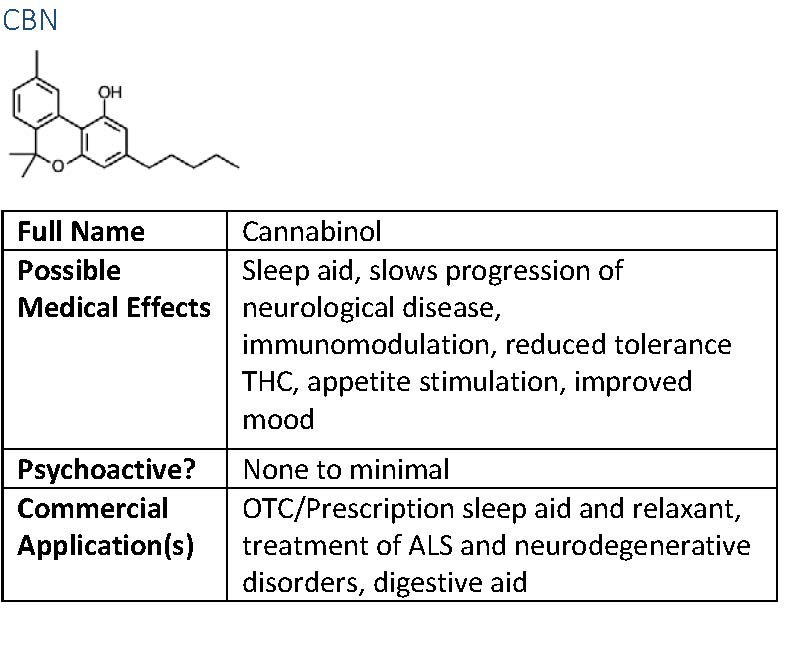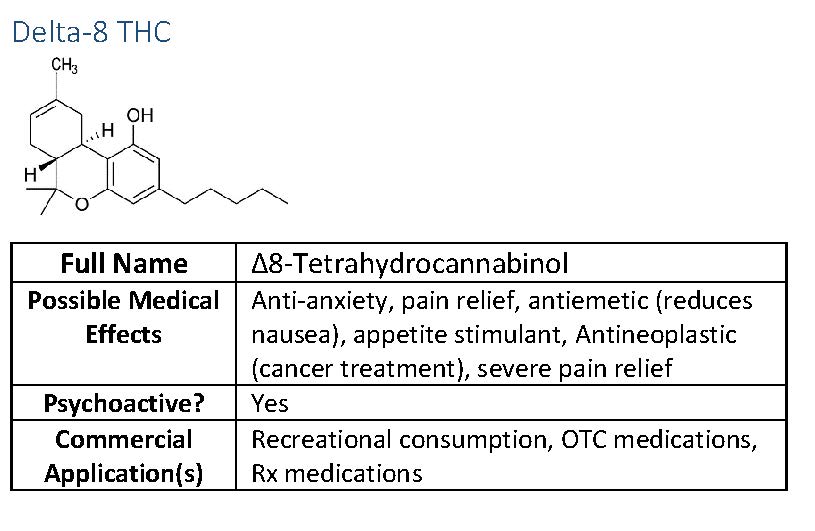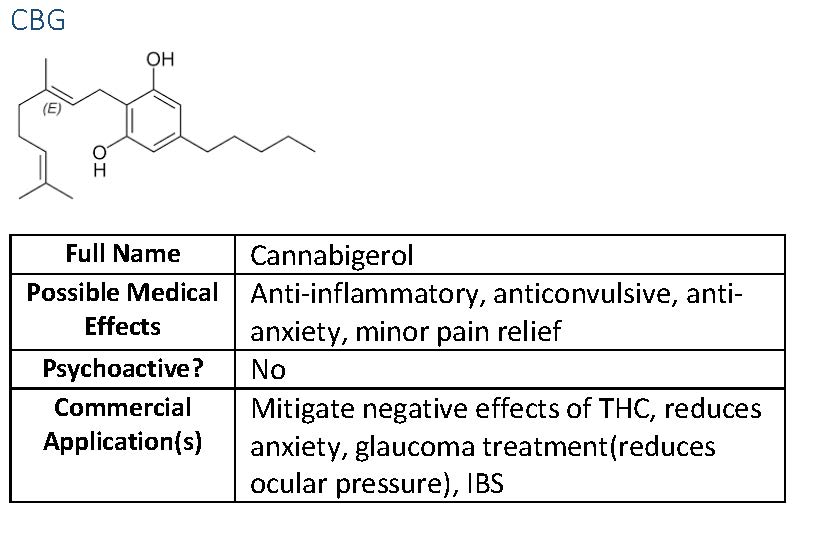Uncharted Territory – Part II
Marijuana Industry NewsMedical Marijuana May 27, 2019 MJ Shareholders 0

Possible candidates for the next big cannabinoid
In Uncharted Territory: how changing the way we think about cannabis will create new commercial opportunities, we explored how THC and CBD are just two of over 100 unique compounds found in the cannabis plant, known as cannabinoids. A growing body of research indicates that several less-abundant cannabinoids may provide a variety of medical benefits that enhance the effectiveness of THC and CBD. Others may prove effective primary treatments in their own right. Let’s take a closer look at three of these cannabinoids and the commercial applications they may hold for the nascent cannabis industry. Specifically we will delve deeper into CBN, Delta-8 THC and CBG.

CBN is a unique molecule, even among other cannabinoids. As a metabolite (byproduct) of the breakdown of THC, CBN can only be obtained in meaningful quantities by aging high-THC plant material. Over time, the THC contained in cannabis undergoes several reactions to transform into CBN. Treating the plant material with artificial ultraviolet light may also hasten the time period required for this transformation.
CBN is thought to be a powerful sleep aid[i]that exhibits a synergistic (or “entourage”) effect when paired with THC. However, because it lacks the same affinity for the CB1 receptor as THC, CBN delivers many of the benefits of THC without the associated “high”, including reduced neural and muscle spasms and improved mood. By simultaneously treating conditions that result from poor sleep, a cannabinoid treatment regimen including CBN may provide more effective outcomes than current prescription sleep aids that carry serious negative side effects and interactions.
The early stages of research into CBN suggests that it may address numerous neurological ailments. In 2004 and 2005, the Journal of ALS and Other Neuron Disorderspublished several studies that showed CBN effective in delaying the progression Of ALS in mice. Large-scale human trials are still needed to see what CBN is capable of.
Just like a fine wine gains value over time through fermentation, CBN also supports the old adage that “time is money”. Since high-THC cannabis is also highly marketable, growers may not be willing or able to sacrifice immediate revenue to create reserves of high-THC product—only to let the product turn. This could lead to supply shortage as CBN increases in popularity and a hypercompetitive cannabis retail market looks to capitalize on a finite resource.
Although a handful of CBN retail products are available, they are still hard to come by and unfamiliar to most cannabis consumers. Eventually, CBN may find itself on the shelves of chain pharmacies or as a component in a drug to treat neurodegenerative diseases. If either case materializes, the path-dependent nature of CBN will create a supply shortage in the early days of this popularity. Savvy cultivators who are willing to store and age perfectly good product for a rainy day will be well positioned to benefit from such a shortage.

In general, THC refers to the molecule Δ9-Tetrahydrocannabinol. This poster child of the cannabis plant has a closely related cousin with some subtle differences—that cannabinoid is Δ8-Tetrahydrocannabinol, or “Delta-8 THC”.
Delta 8 THC it has been shown to be antiemetic (reduces nausea) and to boost the neurotransmitter acetylcholine. Since deficiencies in acetylcholine are thought to contribute to cognitive disorders, it may have beneficial uses in the treatment of Alzheimer’s and behavioral disturbances. Delta-8 THC’s psychoactive effects are generally described as a milder form than its Delta-9 cousin, and better tolerated by cannabis-naïve individuals.
Perhaps the most intriguing Delta-8 discovery comes to us from a 1974 US government study, where evidence suggested it killed cancer cells.[ii]Conducted with a grant from the taxpayer-funded US Public Health Service, the study found reduction in the growth of certain types of lung cancer cells in mice. Despite these results and a $5.74 billion budget allocation in 2019[iii], the federally-funded National Cancer Institute has not conducted additional studies.

CBG (and its acidic form CBGa[iv]) are considered the “mother cannabinoids” of the cannabis plant. By altering the structure of CBG with certain enzymes, the cannabis plant biosynthesizes a wide range of other cannabinoids found in the plant. Since CBG is present for a limited period in the plant before it is converted to other substances, we find it in lower amounts—typically under 1% of cannabinoids by weight.
As of the publication of this article, no clinical research has been done on the effects of CBG on human subjects. Promising results found for the treatment of IBS and colitis [v]CBG is also believed to counteract some of the undesirable side effects of THC by changing the way it binds to endocannabinoid receptors.[vi]
From a commercial perspective, developing an effective way to harvest CBG in greater quantities could produce a competitive supply advantage. As a precursor molecule, CBG is also the most obvious starting point for producing synthetic analogs of cannabinoids that do not occur in high amounts naturally in high concentrations.
The Takeaway
The momentum behind the cannabis legalization movement is growing. If this trend continues, the lesser-known cannabinoids could steal some of the spotlight from THC and CBD. The three cannabinoids discussed above represent only a small percentage of what is available from the plant. The sheer number of cannabinoids and the overwhelming list of uses already discovered create a compelling argument that there is more to come. It is possible that the most profound use of cannabis as a medicine remains undiscovered, for now.
It’s also important to temper any forward-looking statements on the potential benefits of cannabinoids with knowledge and scrutiny. The claim that cannabis is an effective cancer treatment is unproven and premature at this time. However, this uncertainty is precisely why additional research is needed. As national and global perceptions of cannabis begin to evolve, additional commercial opportunities may be just over the horizon. The businesses and investors who understand cannabinoids (and the cannabis plant as a whole) will be well positioned to profit from these opportunities when the time comes.
[i]Karniol IG, Shirakawa I, Takahashi RN, Knobel E, Musty RE (1975). “Effects of delta9-tetrahydrocannabinol and cannabinol in man”. Pharmacology. 13(6): 502–12.
[iv]CBG is he decarboxylated version of the CBGa molecule. For the simplicity, CBG is used to refer to both CBG and CBGa in this article.
[v]Couch, D. G; Maudslay, H; Doleman, B; Lund, J. N; O’Sullivan, S. E (2018). “The use of cannabinoids in colitis: A systematic review and meta-analysis”. Inflammatory Bowel Diseases. 24(4): 680–697
[vi]Cascio, MG (2010). “Evidence that the plant cannabinoid cannabigerol is a highly potent alpha2-adrenoceptor agonist and moderately potent 5HT1A receptor antagonist”. British Journal of Pharmacology.
MJ Shareholders
MJShareholders.com is the largest dedicated financial network and leading corporate communications firm serving the legal cannabis industry. Our network aims to connect public marijuana companies with these focused cannabis audiences across the US and Canada that are critical for growth: Short and long term cannabis investors Active funding sources Mainstream media Business leaders Cannabis consumers










No comments so far.
Be first to leave comment below.